HA2042 Case Study: Evaluating Adam & Co.'s Accounting Systems
VerifiedAdded on 2022/11/25
|13
|3183
|441
Case Study
AI Summary
This case study examines the accounting information systems of Adam & Co., a wholesale industrial supplies business. The report analyzes the purchases, cash disbursements, and payroll systems using flowcharts to illustrate their processes. It identifies weaknesses in each system, such as excess staffing in purchases, lack of supervision in cash disbursements, and potential for fraud. The analysis includes risks associated with foreign suppliers, quality control, and budget allocation. The study concludes by offering recommendations to improve internal controls, address inefficiencies, and mitigate risks within each accounting system. The assignment emphasizes the importance of efficient accounting practices and robust internal controls for business operations. This analysis is provided by a student and available on Desklib, a platform offering AI-driven study tools.
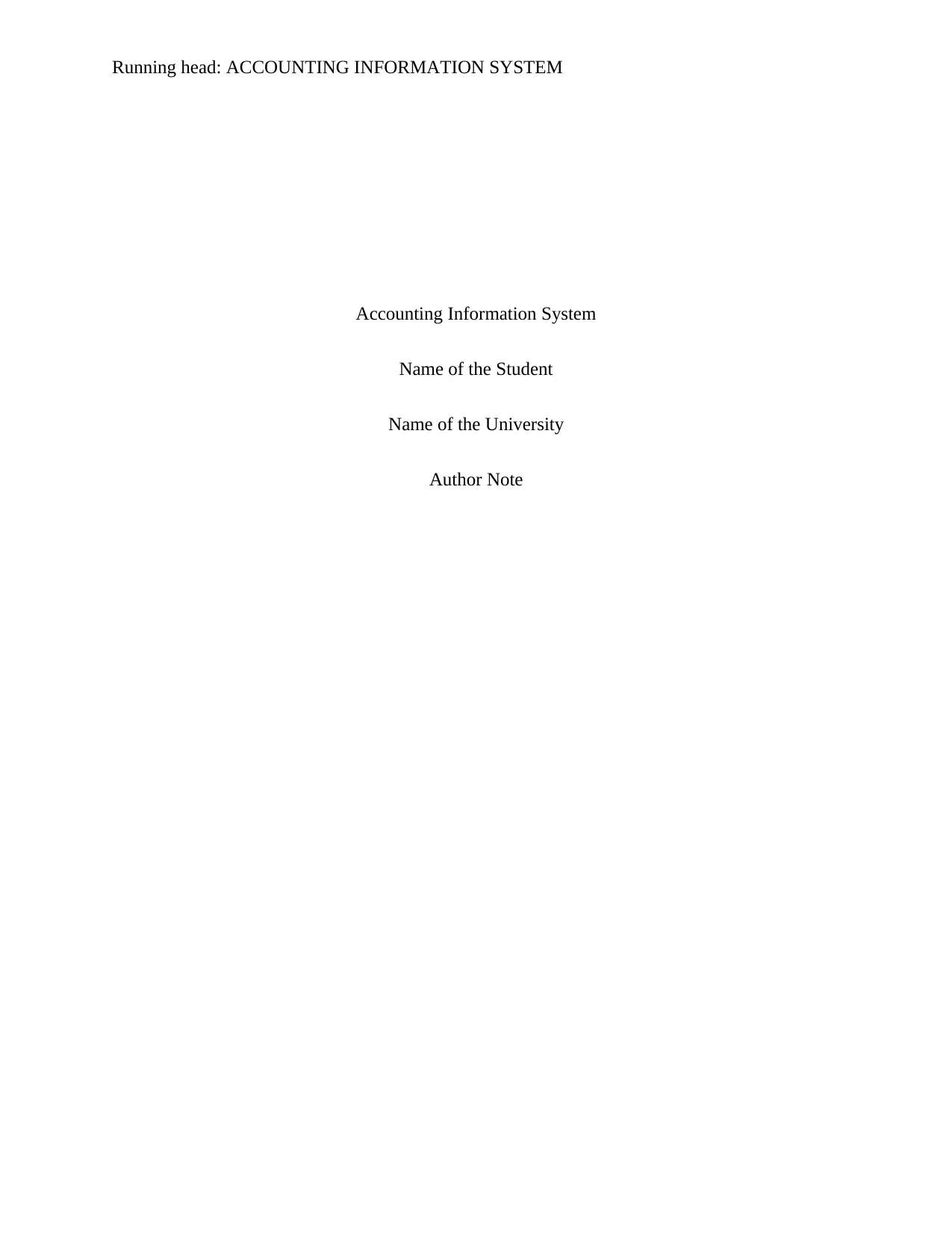
Running head: ACCOUNTING INFORMATION SYSTEM
Accounting Information System
Name of the Student
Name of the University
Author Note
Accounting Information System
Name of the Student
Name of the University
Author Note
Paraphrase This Document
Need a fresh take? Get an instant paraphrase of this document with our AI Paraphraser
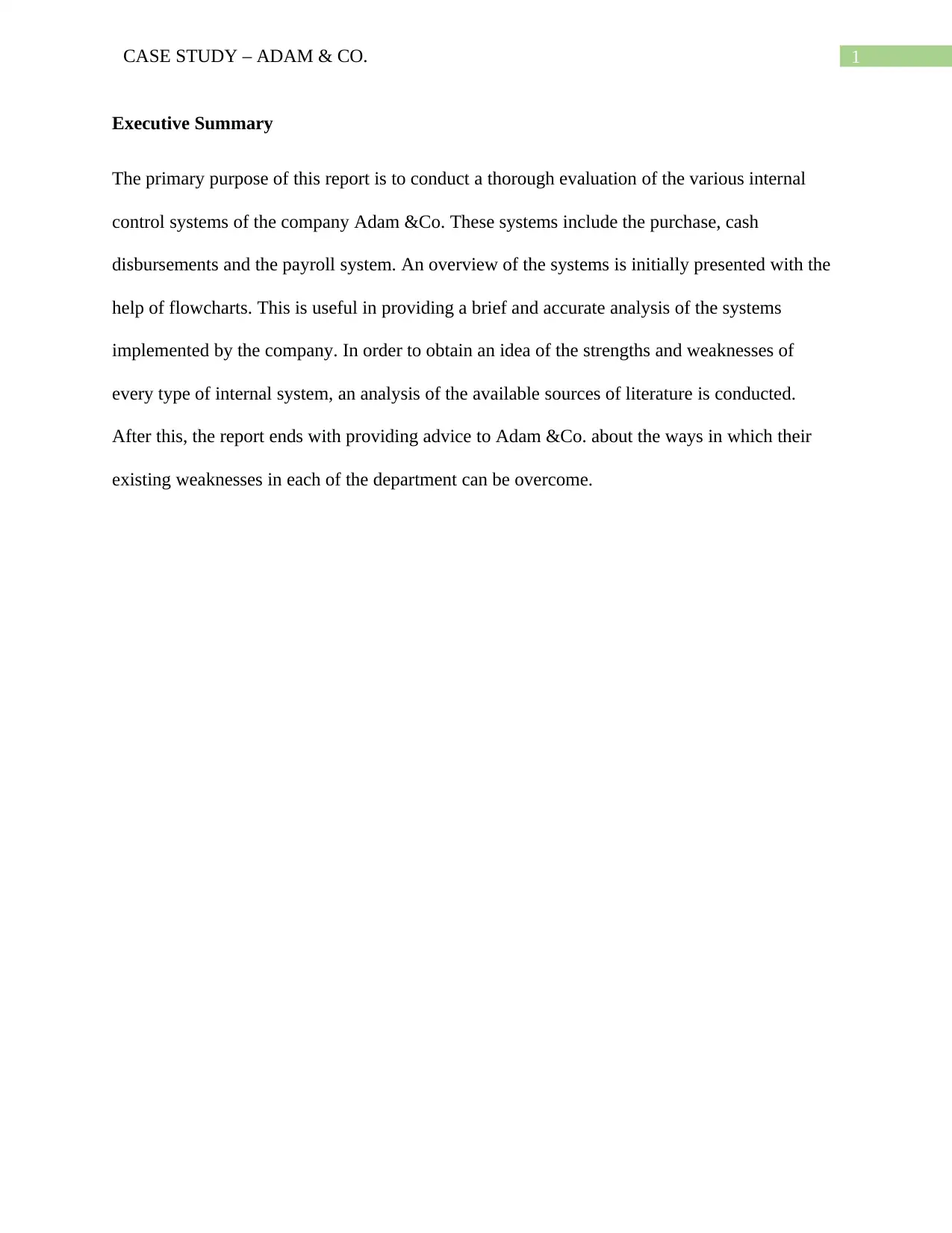
1CASE STUDY – ADAM & CO.
Executive Summary
The primary purpose of this report is to conduct a thorough evaluation of the various internal
control systems of the company Adam &Co. These systems include the purchase, cash
disbursements and the payroll system. An overview of the systems is initially presented with the
help of flowcharts. This is useful in providing a brief and accurate analysis of the systems
implemented by the company. In order to obtain an idea of the strengths and weaknesses of
every type of internal system, an analysis of the available sources of literature is conducted.
After this, the report ends with providing advice to Adam &Co. about the ways in which their
existing weaknesses in each of the department can be overcome.
Executive Summary
The primary purpose of this report is to conduct a thorough evaluation of the various internal
control systems of the company Adam &Co. These systems include the purchase, cash
disbursements and the payroll system. An overview of the systems is initially presented with the
help of flowcharts. This is useful in providing a brief and accurate analysis of the systems
implemented by the company. In order to obtain an idea of the strengths and weaknesses of
every type of internal system, an analysis of the available sources of literature is conducted.
After this, the report ends with providing advice to Adam &Co. about the ways in which their
existing weaknesses in each of the department can be overcome.

2CASE STUDY – ADAM & CO.
Table of Contents
Introduction..................................................................................................................................3
System flowchart of purchases system........................................................................................4
System flowchart of cash disbursements system.........................................................................5
System flowchart of payroll system.............................................................................................6
Description of weaknesses and risks of the purchases system.....................................................7
Internal control weakness in the Cash Disbursements System....................................................8
Description of internal control weakness in the Payroll System.................................................9
Conclusion.................................................................................................................................10
List of References......................................................................................................................12
Table of Contents
Introduction..................................................................................................................................3
System flowchart of purchases system........................................................................................4
System flowchart of cash disbursements system.........................................................................5
System flowchart of payroll system.............................................................................................6
Description of weaknesses and risks of the purchases system.....................................................7
Internal control weakness in the Cash Disbursements System....................................................8
Description of internal control weakness in the Payroll System.................................................9
Conclusion.................................................................................................................................10
List of References......................................................................................................................12
⊘ This is a preview!⊘
Do you want full access?
Subscribe today to unlock all pages.

Trusted by 1+ million students worldwide
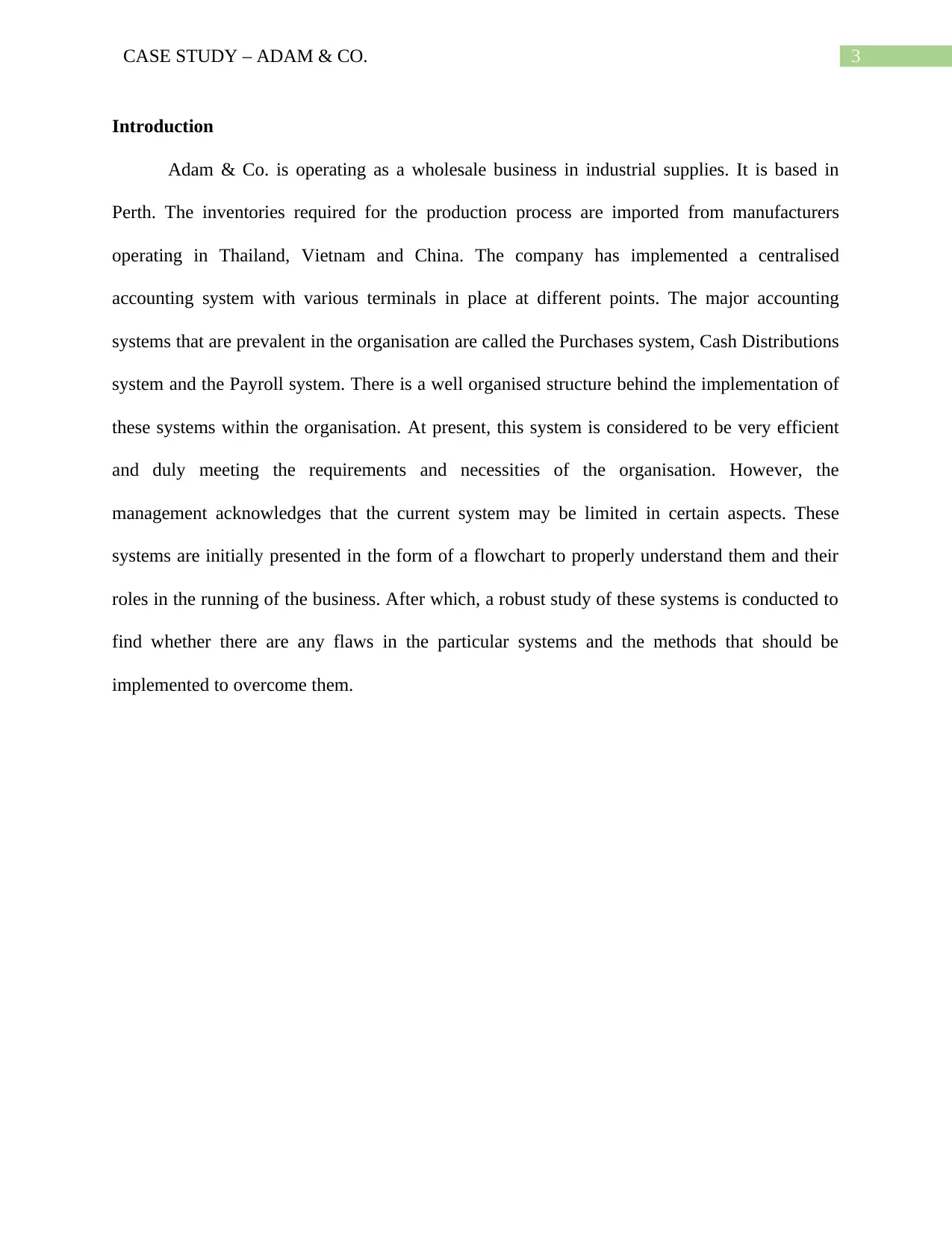
3CASE STUDY – ADAM & CO.
Introduction
Adam & Co. is operating as a wholesale business in industrial supplies. It is based in
Perth. The inventories required for the production process are imported from manufacturers
operating in Thailand, Vietnam and China. The company has implemented a centralised
accounting system with various terminals in place at different points. The major accounting
systems that are prevalent in the organisation are called the Purchases system, Cash Distributions
system and the Payroll system. There is a well organised structure behind the implementation of
these systems within the organisation. At present, this system is considered to be very efficient
and duly meeting the requirements and necessities of the organisation. However, the
management acknowledges that the current system may be limited in certain aspects. These
systems are initially presented in the form of a flowchart to properly understand them and their
roles in the running of the business. After which, a robust study of these systems is conducted to
find whether there are any flaws in the particular systems and the methods that should be
implemented to overcome them.
Introduction
Adam & Co. is operating as a wholesale business in industrial supplies. It is based in
Perth. The inventories required for the production process are imported from manufacturers
operating in Thailand, Vietnam and China. The company has implemented a centralised
accounting system with various terminals in place at different points. The major accounting
systems that are prevalent in the organisation are called the Purchases system, Cash Distributions
system and the Payroll system. There is a well organised structure behind the implementation of
these systems within the organisation. At present, this system is considered to be very efficient
and duly meeting the requirements and necessities of the organisation. However, the
management acknowledges that the current system may be limited in certain aspects. These
systems are initially presented in the form of a flowchart to properly understand them and their
roles in the running of the business. After which, a robust study of these systems is conducted to
find whether there are any flaws in the particular systems and the methods that should be
implemented to overcome them.
Paraphrase This Document
Need a fresh take? Get an instant paraphrase of this document with our AI Paraphraser
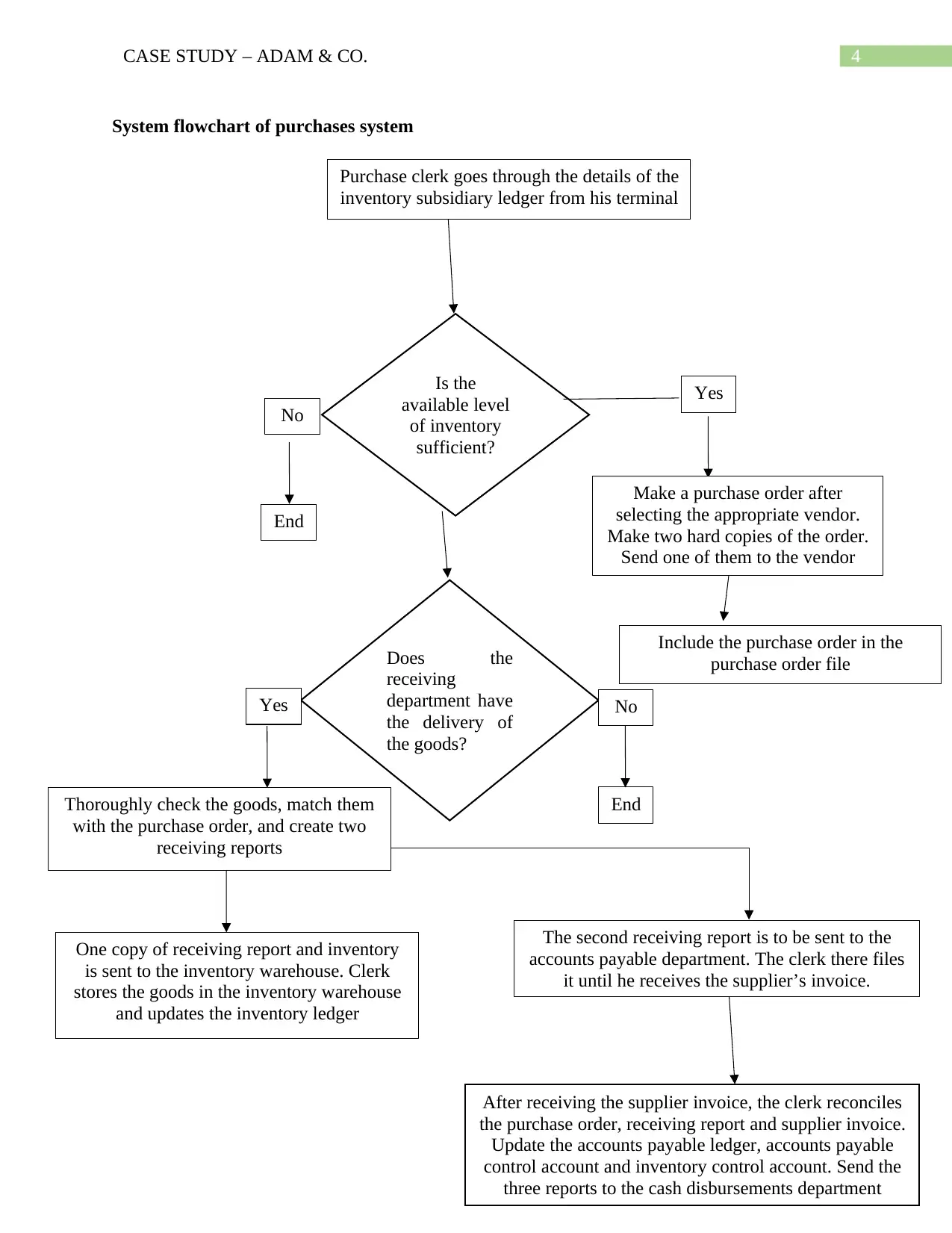
4CASE STUDY – ADAM & CO.
System flowchart of purchases system
Yes
No
Make a purchase order after
selecting the appropriate vendor.
Make two hard copies of the order.
Send one of them to the vendor
Purchase clerk goes through the details of the
inventory subsidiary ledger from his terminal
Is the
available level
of inventory
sufficient?
Include the purchase order in the
purchase order file
End
Does the
receiving
department have
the delivery of
the goods?
Yes
Thoroughly check the goods, match them
with the purchase order, and create two
receiving reports
One copy of receiving report and inventory
is sent to the inventory warehouse. Clerk
stores the goods in the inventory warehouse
and updates the inventory ledger
The second receiving report is to be sent to the
accounts payable department. The clerk there files
it until he receives the supplier’s invoice.
No
End
After receiving the supplier invoice, the clerk reconciles
the purchase order, receiving report and supplier invoice.
Update the accounts payable ledger, accounts payable
control account and inventory control account. Send the
three reports to the cash disbursements department
System flowchart of purchases system
Yes
No
Make a purchase order after
selecting the appropriate vendor.
Make two hard copies of the order.
Send one of them to the vendor
Purchase clerk goes through the details of the
inventory subsidiary ledger from his terminal
Is the
available level
of inventory
sufficient?
Include the purchase order in the
purchase order file
End
Does the
receiving
department have
the delivery of
the goods?
Yes
Thoroughly check the goods, match them
with the purchase order, and create two
receiving reports
One copy of receiving report and inventory
is sent to the inventory warehouse. Clerk
stores the goods in the inventory warehouse
and updates the inventory ledger
The second receiving report is to be sent to the
accounts payable department. The clerk there files
it until he receives the supplier’s invoice.
No
End
After receiving the supplier invoice, the clerk reconciles
the purchase order, receiving report and supplier invoice.
Update the accounts payable ledger, accounts payable
control account and inventory control account. Send the
three reports to the cash disbursements department

5CASE STUDY – ADAM & CO.
System flowchart of cash disbursements system
Has the purchase
clerk sent the
required documents
in an appropriate
manner?
Yes No
Cash department clerk stores
the documents till the due date
of payment arrives
End
Is the due date
applicable?Yes No
Make a cheque for the invoiced
account and send it to the treasurer
End
Treasurer signs the cheque and mails
the same to the vendor Update the cheque register, accounts payable ledger
and the accounts payable control account.
File the invoice, purchase order copy, receiving
report and cheque copy in the department
System flowchart of cash disbursements system
Has the purchase
clerk sent the
required documents
in an appropriate
manner?
Yes No
Cash department clerk stores
the documents till the due date
of payment arrives
End
Is the due date
applicable?Yes No
Make a cheque for the invoiced
account and send it to the treasurer
End
Treasurer signs the cheque and mails
the same to the vendor Update the cheque register, accounts payable ledger
and the accounts payable control account.
File the invoice, purchase order copy, receiving
report and cheque copy in the department
⊘ This is a preview!⊘
Do you want full access?
Subscribe today to unlock all pages.

Trusted by 1+ million students worldwide
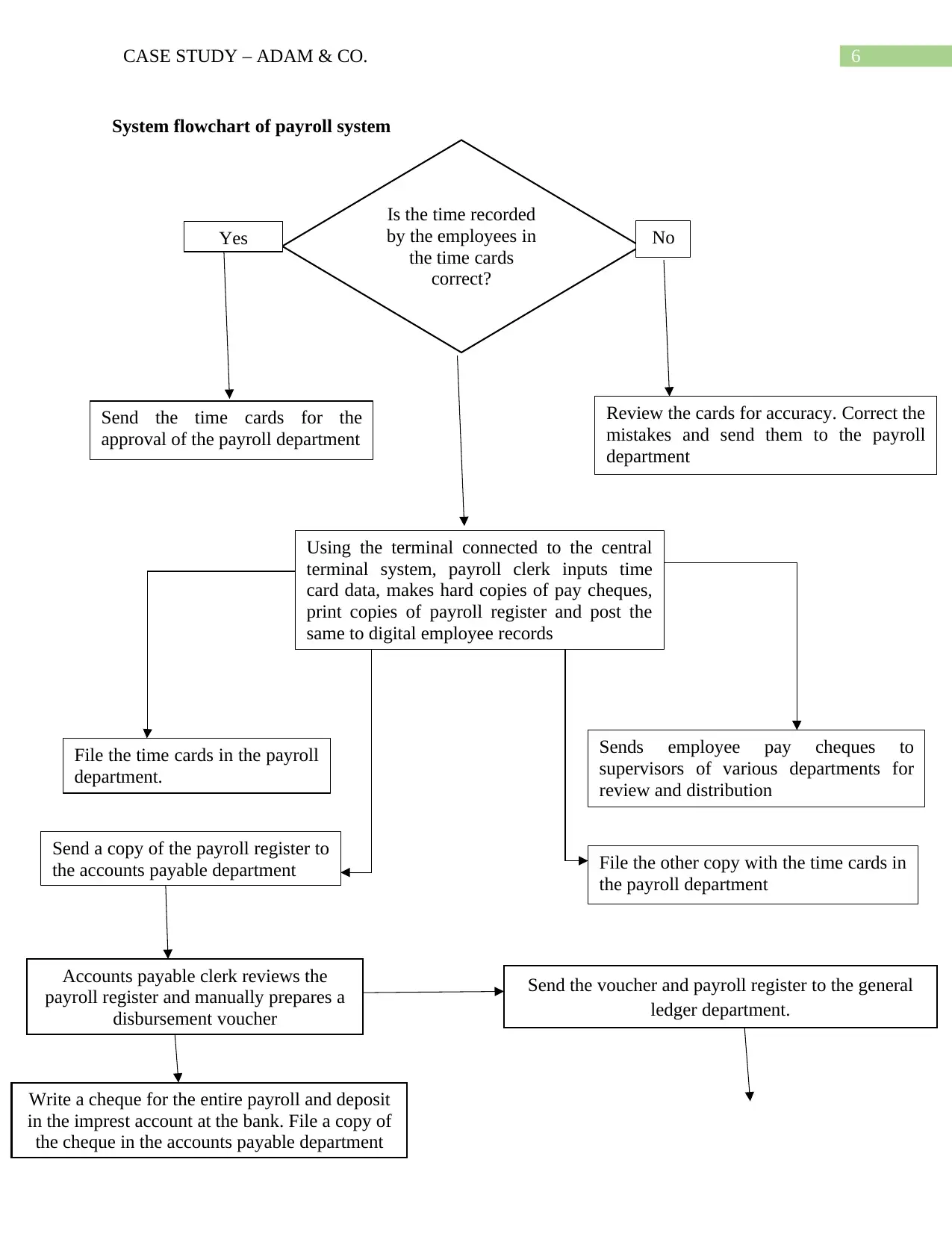
6CASE STUDY – ADAM & CO.
System flowchart of payroll system
Review the cards for accuracy. Correct the
mistakes and send them to the payroll
department
Send the time cards for the
approval of the payroll department
Is the time recorded
by the employees in
the time cards
correct?
Yes No
Using the terminal connected to the central
terminal system, payroll clerk inputs time
card data, makes hard copies of pay cheques,
print copies of payroll register and post the
same to digital employee records
Send a copy of the payroll register to
the accounts payable department
Sends employee pay cheques to
supervisors of various departments for
review and distribution
File the other copy with the time cards in
the payroll department
File the time cards in the payroll
department.
Accounts payable clerk reviews the
payroll register and manually prepares a
disbursement voucher
Send the voucher and payroll register to the general
ledger department.
Write a cheque for the entire payroll and deposit
in the imprest account at the bank. File a copy of
the cheque in the accounts payable department
System flowchart of payroll system
Review the cards for accuracy. Correct the
mistakes and send them to the payroll
department
Send the time cards for the
approval of the payroll department
Is the time recorded
by the employees in
the time cards
correct?
Yes No
Using the terminal connected to the central
terminal system, payroll clerk inputs time
card data, makes hard copies of pay cheques,
print copies of payroll register and post the
same to digital employee records
Send a copy of the payroll register to
the accounts payable department
Sends employee pay cheques to
supervisors of various departments for
review and distribution
File the other copy with the time cards in
the payroll department
File the time cards in the payroll
department.
Accounts payable clerk reviews the
payroll register and manually prepares a
disbursement voucher
Send the voucher and payroll register to the general
ledger department.
Write a cheque for the entire payroll and deposit
in the imprest account at the bank. File a copy of
the cheque in the accounts payable department
Paraphrase This Document
Need a fresh take? Get an instant paraphrase of this document with our AI Paraphraser

7CASE STUDY – ADAM & CO.
Description of weaknesses and risks of the purchases system
Excess staffing is the main problem that can be observed in the purchases system. There
are way too many people who are charged with the responsibility of ensuring that the system
runs in a smooth manner. The responsibility of understanding and determining whether the stock
levels are too low is vested with one clerk. When this clerk thinks that the available stock levels
are too low, then he places an order for the goods from a particular vendor and receives the
goods from the particular vendor. After receiving the goods, he sends them to another clerk in
the department who undertakes the responsibility of safeguarding the goods and maintaining
them properly for future usage. Out of the two receiving reports prepared by the clerk in the
purchase department, one of them is sent to the clerk operating in the accounts payable
department. The other report has to be safeguarded by him until he receives the invoice from the
supplier. On receiving the invoice from the supplier, another temporary file has to be created and
the purchase order, receiving report and the supplier’s invoice are to be reconciled together.
There are not many aspects in this system to suggest that the system being implemented in the
organisation is not efficient. However, it is evident that the costs involved in the maintenance of
the department and its procedures are extremely expensive. With regards to the purchases
system, the biggest risk is the committing of frauds by suppliers. Other identifiable risks are
related to the delivery of goods from a foreign country and the problems that arise on receiving
low quality goods from those suppliers (Sandberg and Mena 2015). Risks also provide further
evidence about the presence of inefficiencies in the system implemented by Adam & Co. One of
them is the lack of a proper mechanism to quickly identify the quality of the goods received from
the suppliers. Receiving low quality products leads to a delay in the production of the goods and
Post to the general ledger from the computer
terminal and file them in the department
Description of weaknesses and risks of the purchases system
Excess staffing is the main problem that can be observed in the purchases system. There
are way too many people who are charged with the responsibility of ensuring that the system
runs in a smooth manner. The responsibility of understanding and determining whether the stock
levels are too low is vested with one clerk. When this clerk thinks that the available stock levels
are too low, then he places an order for the goods from a particular vendor and receives the
goods from the particular vendor. After receiving the goods, he sends them to another clerk in
the department who undertakes the responsibility of safeguarding the goods and maintaining
them properly for future usage. Out of the two receiving reports prepared by the clerk in the
purchase department, one of them is sent to the clerk operating in the accounts payable
department. The other report has to be safeguarded by him until he receives the invoice from the
supplier. On receiving the invoice from the supplier, another temporary file has to be created and
the purchase order, receiving report and the supplier’s invoice are to be reconciled together.
There are not many aspects in this system to suggest that the system being implemented in the
organisation is not efficient. However, it is evident that the costs involved in the maintenance of
the department and its procedures are extremely expensive. With regards to the purchases
system, the biggest risk is the committing of frauds by suppliers. Other identifiable risks are
related to the delivery of goods from a foreign country and the problems that arise on receiving
low quality goods from those suppliers (Sandberg and Mena 2015). Risks also provide further
evidence about the presence of inefficiencies in the system implemented by Adam & Co. One of
them is the lack of a proper mechanism to quickly identify the quality of the goods received from
the suppliers. Receiving low quality products leads to a delay in the production of the goods and
Post to the general ledger from the computer
terminal and file them in the department
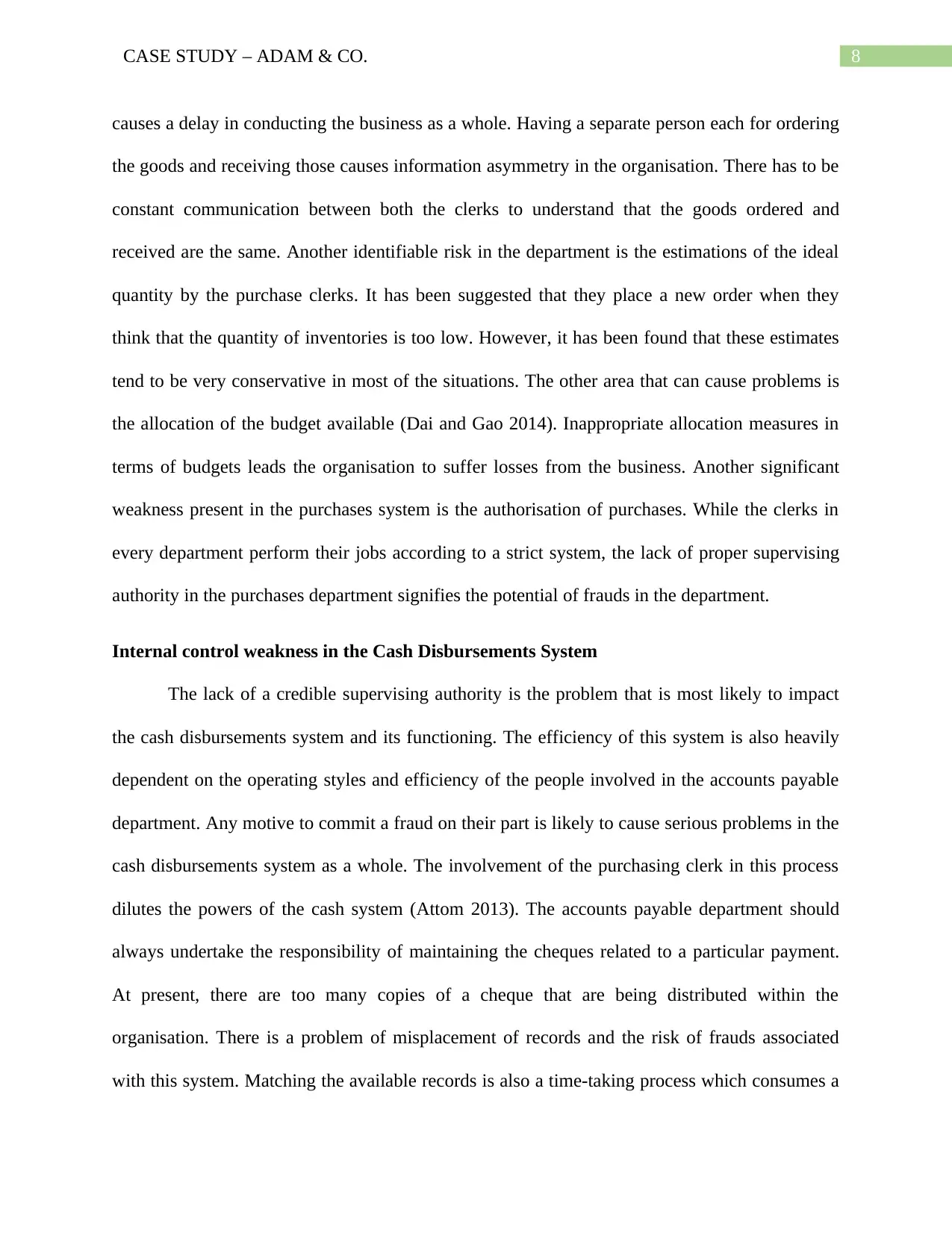
8CASE STUDY – ADAM & CO.
causes a delay in conducting the business as a whole. Having a separate person each for ordering
the goods and receiving those causes information asymmetry in the organisation. There has to be
constant communication between both the clerks to understand that the goods ordered and
received are the same. Another identifiable risk in the department is the estimations of the ideal
quantity by the purchase clerks. It has been suggested that they place a new order when they
think that the quantity of inventories is too low. However, it has been found that these estimates
tend to be very conservative in most of the situations. The other area that can cause problems is
the allocation of the budget available (Dai and Gao 2014). Inappropriate allocation measures in
terms of budgets leads the organisation to suffer losses from the business. Another significant
weakness present in the purchases system is the authorisation of purchases. While the clerks in
every department perform their jobs according to a strict system, the lack of proper supervising
authority in the purchases department signifies the potential of frauds in the department.
Internal control weakness in the Cash Disbursements System
The lack of a credible supervising authority is the problem that is most likely to impact
the cash disbursements system and its functioning. The efficiency of this system is also heavily
dependent on the operating styles and efficiency of the people involved in the accounts payable
department. Any motive to commit a fraud on their part is likely to cause serious problems in the
cash disbursements system as a whole. The involvement of the purchasing clerk in this process
dilutes the powers of the cash system (Attom 2013). The accounts payable department should
always undertake the responsibility of maintaining the cheques related to a particular payment.
At present, there are too many copies of a cheque that are being distributed within the
organisation. There is a problem of misplacement of records and the risk of frauds associated
with this system. Matching the available records is also a time-taking process which consumes a
causes a delay in conducting the business as a whole. Having a separate person each for ordering
the goods and receiving those causes information asymmetry in the organisation. There has to be
constant communication between both the clerks to understand that the goods ordered and
received are the same. Another identifiable risk in the department is the estimations of the ideal
quantity by the purchase clerks. It has been suggested that they place a new order when they
think that the quantity of inventories is too low. However, it has been found that these estimates
tend to be very conservative in most of the situations. The other area that can cause problems is
the allocation of the budget available (Dai and Gao 2014). Inappropriate allocation measures in
terms of budgets leads the organisation to suffer losses from the business. Another significant
weakness present in the purchases system is the authorisation of purchases. While the clerks in
every department perform their jobs according to a strict system, the lack of proper supervising
authority in the purchases department signifies the potential of frauds in the department.
Internal control weakness in the Cash Disbursements System
The lack of a credible supervising authority is the problem that is most likely to impact
the cash disbursements system and its functioning. The efficiency of this system is also heavily
dependent on the operating styles and efficiency of the people involved in the accounts payable
department. Any motive to commit a fraud on their part is likely to cause serious problems in the
cash disbursements system as a whole. The involvement of the purchasing clerk in this process
dilutes the powers of the cash system (Attom 2013). The accounts payable department should
always undertake the responsibility of maintaining the cheques related to a particular payment.
At present, there are too many copies of a cheque that are being distributed within the
organisation. There is a problem of misplacement of records and the risk of frauds associated
with this system. Matching the available records is also a time-taking process which consumes a
⊘ This is a preview!⊘
Do you want full access?
Subscribe today to unlock all pages.

Trusted by 1+ million students worldwide
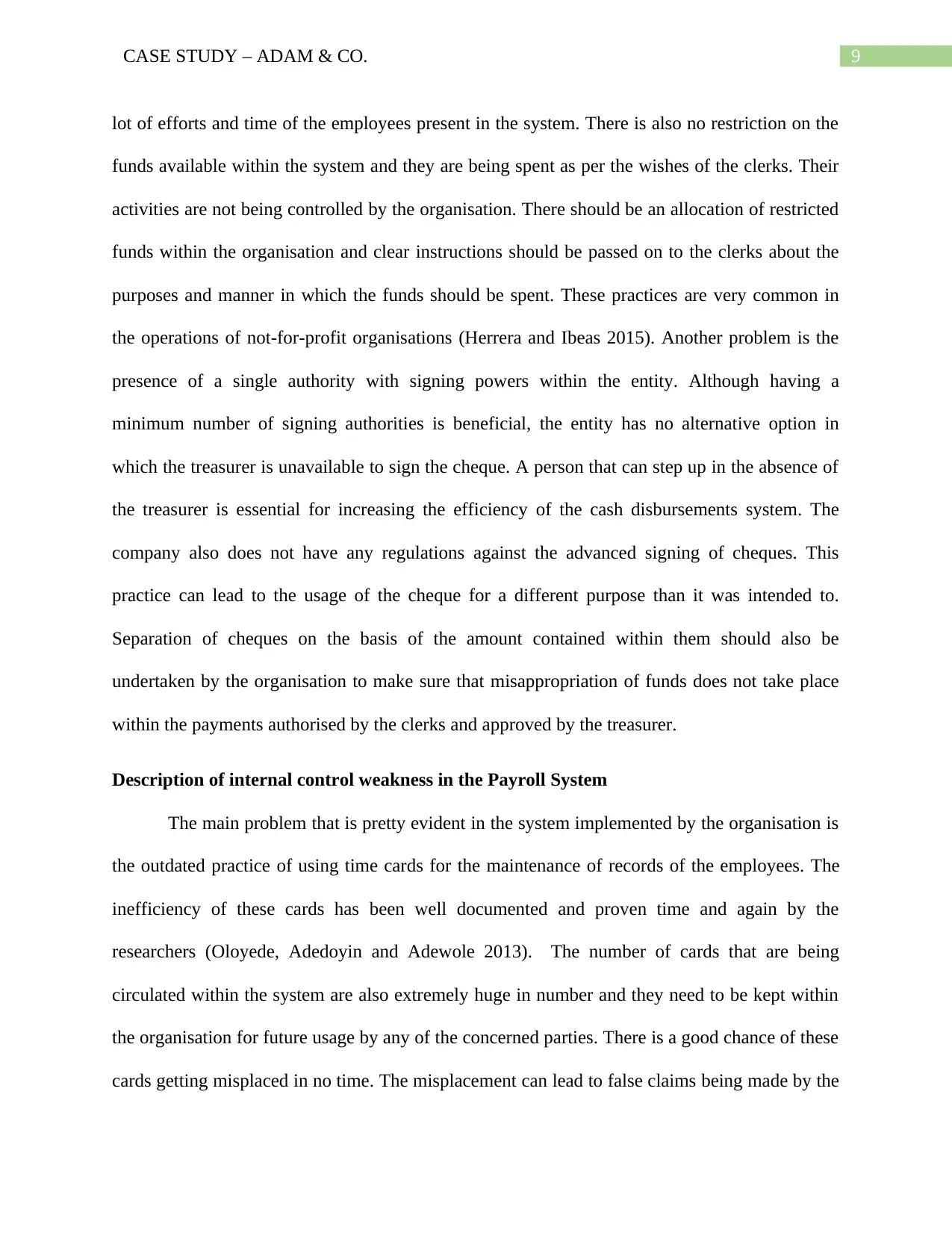
9CASE STUDY – ADAM & CO.
lot of efforts and time of the employees present in the system. There is also no restriction on the
funds available within the system and they are being spent as per the wishes of the clerks. Their
activities are not being controlled by the organisation. There should be an allocation of restricted
funds within the organisation and clear instructions should be passed on to the clerks about the
purposes and manner in which the funds should be spent. These practices are very common in
the operations of not-for-profit organisations (Herrera and Ibeas 2015). Another problem is the
presence of a single authority with signing powers within the entity. Although having a
minimum number of signing authorities is beneficial, the entity has no alternative option in
which the treasurer is unavailable to sign the cheque. A person that can step up in the absence of
the treasurer is essential for increasing the efficiency of the cash disbursements system. The
company also does not have any regulations against the advanced signing of cheques. This
practice can lead to the usage of the cheque for a different purpose than it was intended to.
Separation of cheques on the basis of the amount contained within them should also be
undertaken by the organisation to make sure that misappropriation of funds does not take place
within the payments authorised by the clerks and approved by the treasurer.
Description of internal control weakness in the Payroll System
The main problem that is pretty evident in the system implemented by the organisation is
the outdated practice of using time cards for the maintenance of records of the employees. The
inefficiency of these cards has been well documented and proven time and again by the
researchers (Oloyede, Adedoyin and Adewole 2013). The number of cards that are being
circulated within the system are also extremely huge in number and they need to be kept within
the organisation for future usage by any of the concerned parties. There is a good chance of these
cards getting misplaced in no time. The misplacement can lead to false claims being made by the
lot of efforts and time of the employees present in the system. There is also no restriction on the
funds available within the system and they are being spent as per the wishes of the clerks. Their
activities are not being controlled by the organisation. There should be an allocation of restricted
funds within the organisation and clear instructions should be passed on to the clerks about the
purposes and manner in which the funds should be spent. These practices are very common in
the operations of not-for-profit organisations (Herrera and Ibeas 2015). Another problem is the
presence of a single authority with signing powers within the entity. Although having a
minimum number of signing authorities is beneficial, the entity has no alternative option in
which the treasurer is unavailable to sign the cheque. A person that can step up in the absence of
the treasurer is essential for increasing the efficiency of the cash disbursements system. The
company also does not have any regulations against the advanced signing of cheques. This
practice can lead to the usage of the cheque for a different purpose than it was intended to.
Separation of cheques on the basis of the amount contained within them should also be
undertaken by the organisation to make sure that misappropriation of funds does not take place
within the payments authorised by the clerks and approved by the treasurer.
Description of internal control weakness in the Payroll System
The main problem that is pretty evident in the system implemented by the organisation is
the outdated practice of using time cards for the maintenance of records of the employees. The
inefficiency of these cards has been well documented and proven time and again by the
researchers (Oloyede, Adedoyin and Adewole 2013). The number of cards that are being
circulated within the system are also extremely huge in number and they need to be kept within
the organisation for future usage by any of the concerned parties. There is a good chance of these
cards getting misplaced in no time. The misplacement can lead to false claims being made by the
Paraphrase This Document
Need a fresh take? Get an instant paraphrase of this document with our AI Paraphraser
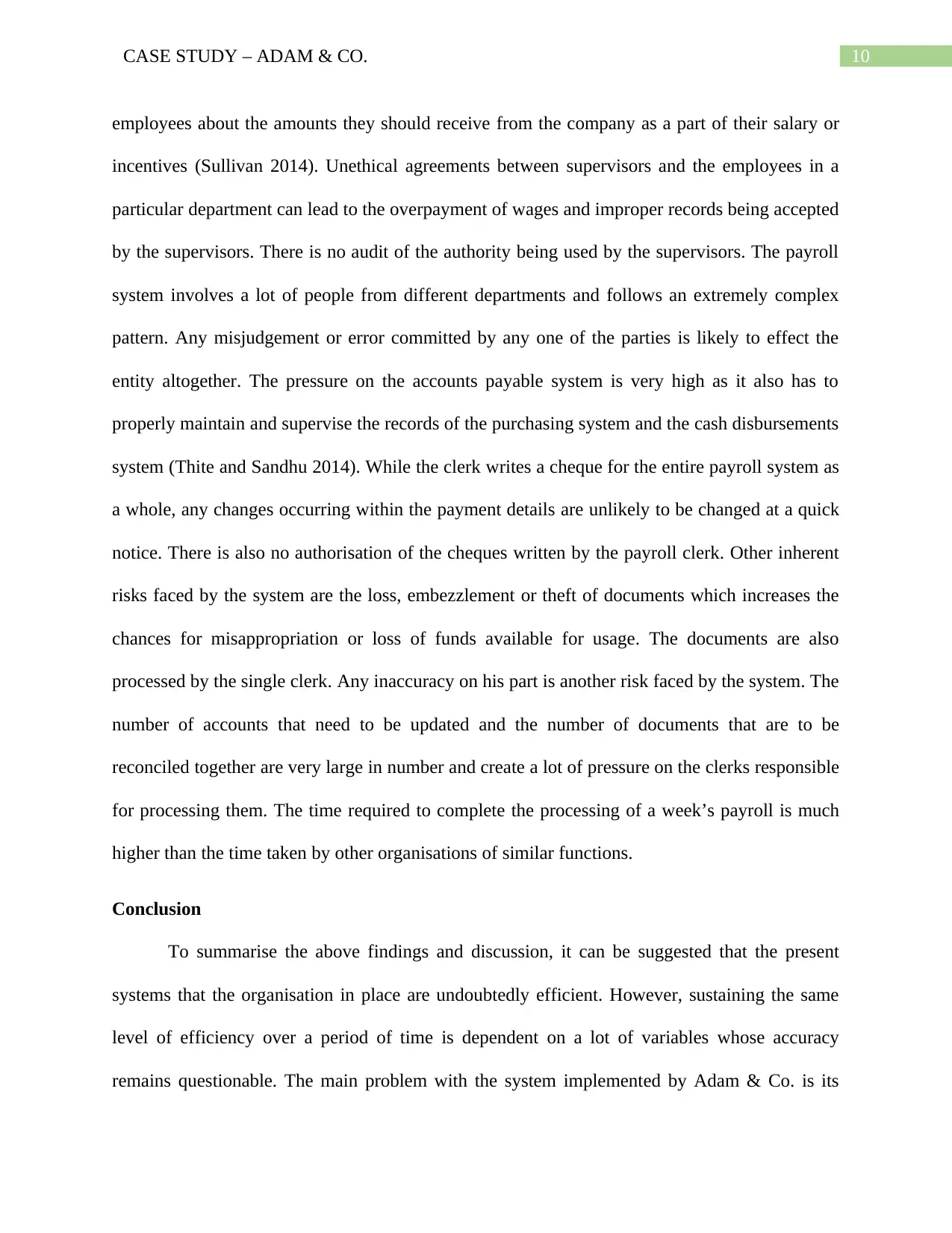
10CASE STUDY – ADAM & CO.
employees about the amounts they should receive from the company as a part of their salary or
incentives (Sullivan 2014). Unethical agreements between supervisors and the employees in a
particular department can lead to the overpayment of wages and improper records being accepted
by the supervisors. There is no audit of the authority being used by the supervisors. The payroll
system involves a lot of people from different departments and follows an extremely complex
pattern. Any misjudgement or error committed by any one of the parties is likely to effect the
entity altogether. The pressure on the accounts payable system is very high as it also has to
properly maintain and supervise the records of the purchasing system and the cash disbursements
system (Thite and Sandhu 2014). While the clerk writes a cheque for the entire payroll system as
a whole, any changes occurring within the payment details are unlikely to be changed at a quick
notice. There is also no authorisation of the cheques written by the payroll clerk. Other inherent
risks faced by the system are the loss, embezzlement or theft of documents which increases the
chances for misappropriation or loss of funds available for usage. The documents are also
processed by the single clerk. Any inaccuracy on his part is another risk faced by the system. The
number of accounts that need to be updated and the number of documents that are to be
reconciled together are very large in number and create a lot of pressure on the clerks responsible
for processing them. The time required to complete the processing of a week’s payroll is much
higher than the time taken by other organisations of similar functions.
Conclusion
To summarise the above findings and discussion, it can be suggested that the present
systems that the organisation in place are undoubtedly efficient. However, sustaining the same
level of efficiency over a period of time is dependent on a lot of variables whose accuracy
remains questionable. The main problem with the system implemented by Adam & Co. is its
employees about the amounts they should receive from the company as a part of their salary or
incentives (Sullivan 2014). Unethical agreements between supervisors and the employees in a
particular department can lead to the overpayment of wages and improper records being accepted
by the supervisors. There is no audit of the authority being used by the supervisors. The payroll
system involves a lot of people from different departments and follows an extremely complex
pattern. Any misjudgement or error committed by any one of the parties is likely to effect the
entity altogether. The pressure on the accounts payable system is very high as it also has to
properly maintain and supervise the records of the purchasing system and the cash disbursements
system (Thite and Sandhu 2014). While the clerk writes a cheque for the entire payroll system as
a whole, any changes occurring within the payment details are unlikely to be changed at a quick
notice. There is also no authorisation of the cheques written by the payroll clerk. Other inherent
risks faced by the system are the loss, embezzlement or theft of documents which increases the
chances for misappropriation or loss of funds available for usage. The documents are also
processed by the single clerk. Any inaccuracy on his part is another risk faced by the system. The
number of accounts that need to be updated and the number of documents that are to be
reconciled together are very large in number and create a lot of pressure on the clerks responsible
for processing them. The time required to complete the processing of a week’s payroll is much
higher than the time taken by other organisations of similar functions.
Conclusion
To summarise the above findings and discussion, it can be suggested that the present
systems that the organisation in place are undoubtedly efficient. However, sustaining the same
level of efficiency over a period of time is dependent on a lot of variables whose accuracy
remains questionable. The main problem with the system implemented by Adam & Co. is its
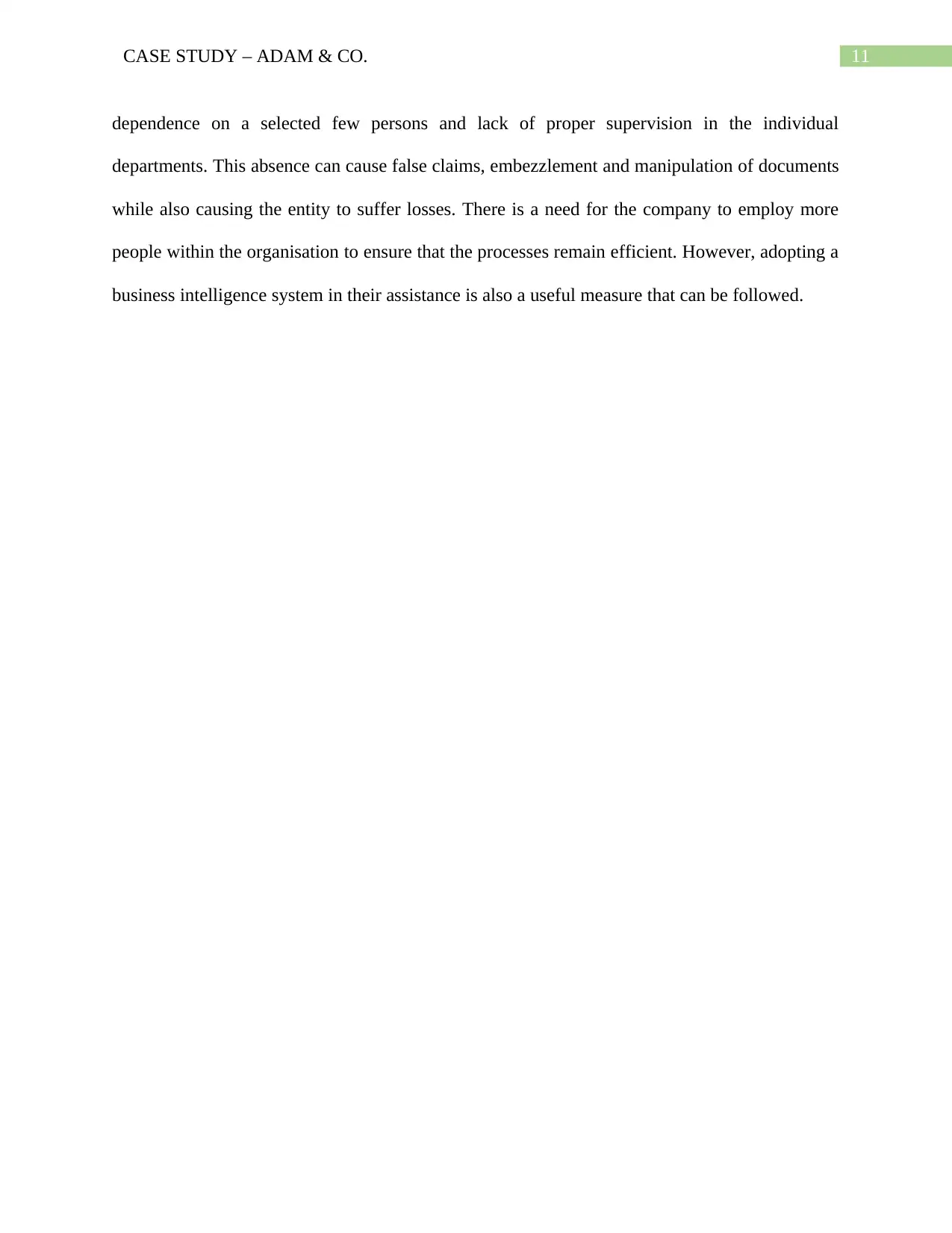
11CASE STUDY – ADAM & CO.
dependence on a selected few persons and lack of proper supervision in the individual
departments. This absence can cause false claims, embezzlement and manipulation of documents
while also causing the entity to suffer losses. There is a need for the company to employ more
people within the organisation to ensure that the processes remain efficient. However, adopting a
business intelligence system in their assistance is also a useful measure that can be followed.
dependence on a selected few persons and lack of proper supervision in the individual
departments. This absence can cause false claims, embezzlement and manipulation of documents
while also causing the entity to suffer losses. There is a need for the company to employ more
people within the organisation to ensure that the processes remain efficient. However, adopting a
business intelligence system in their assistance is also a useful measure that can be followed.
⊘ This is a preview!⊘
Do you want full access?
Subscribe today to unlock all pages.

Trusted by 1+ million students worldwide
1 out of 13
Related Documents
Your All-in-One AI-Powered Toolkit for Academic Success.
+13062052269
info@desklib.com
Available 24*7 on WhatsApp / Email
![[object Object]](/_next/static/media/star-bottom.7253800d.svg)
Unlock your academic potential
Copyright © 2020–2025 A2Z Services. All Rights Reserved. Developed and managed by ZUCOL.




